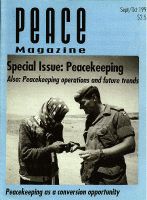
Peace Magazine Sep-Oct 1993, page 27. Some rights reserved.
Search for other articles by John Bacher here
Anatol Rapoport, Univ of Michigan Press 1992
To get a good sense of the importance of Anatol Rapoport's Peace: An Idea Whose Time Has Come, one should set it in the context of his previous magnificent opus, The Origins of Violence (New York: Paragon, 1989). That book's most brilliant contribution was to show how the destructiveness of the Cold War was sustained by "the dogma of the class struggle as the prime mover of history: generalized to all aspects of political and social life." With such ideology, and the Cold War with it, buried in the dust bin of history, Rapoport now turns to the ideology which continues to sustain war. He vividly depicts it as the life blood of a parasitic organism which deflects the resources of society to its own uses without giving anything in return.
In The Origins of Violence Rapoport described how similar messianic universalizing ideologies in the United States contributed to a dangerous deadlock, with equally pretentious creeds supported by the USSR. Now Rapoport believes the economic collapse of the Soviet Union is a warning signal for the "inevitable disaster attendant on a war economy." With the collapse of communism, Rapoport sees Saddam Hussein as "obligingly" stepping into the enemy role to provide "an opportunity for proving that the countless billions spent on high-tech weaponry were well spent."
Rapoport traces the dangerous virulence of the war disease that threatens to wipe out society to the strategies that emerged out of the French Revolution. He notes that Clausewitz's famous dictum about war as the continuation of politics was part of the older, more archaic ideas of the eighteenth century in his thought. More innovative and deadly was his romanticization of war, removing moral constraints and turning him into "the apostle of mass extermination battles." The French Revolution also disastrously turned war from a restrained family dispute between kings into an all-out clash of the will of states, now perceived as the embodiments of the will of peoples. This intensity of national feeling received its strongest expression, Rapoport believes, in the nationalist hysteria that celebrated the onset of World War One. In today less hot-headed environment, Rapoport sees war sustained by think tanks in which battle has become a cool chess game with deadly consequences. Popular support for such toys is secured by various superstitions, most notably that the military createsjobs.
Rapoport prescribes a good dose of revolutionary pacifism to rid humanity of the deadly war virus. This he contrasts to other approaches that fail to attack directly the cancerous growth of the military machine, morally-based pacifism, and international cooperation between states. International cooperation should be seen as the end consequences of a revolutionary pacifist struggle. He notes that although Latin America has achieved a high degree of peaceful cooperation between states, the military in these nations continue to function dangerously as repressors of human fights of their own civilian populations. Like Gene Sharp, Rapoport sees morally or religiously focused pacifism as too slow-and elitist in limiting participation to a sainted few. Rapoport gives an intellectual edge to this revolutionary pacifist agenda, which is the basis for the book's title.
The notion that peace is an idea whose time has come means that all rationales supporting the continued existence of war as an institution can now be exposed as superstitions. Since the facts are on their side, revolutionary pacifists can demonstrate that arguments such as peace-through-strength are superstitions, since militarily strong states, or at least their populations, suffered from wars no less than weak ones and were as frequently defeated. Through such truths, myths such as that nuclear weapons provided peace in Europe since 1945 can be equated to the talisman that someone carries around.

Peace Magazine Sep-Oct 1993, page 27. Some rights reserved.
Search for other articles by John Bacher here